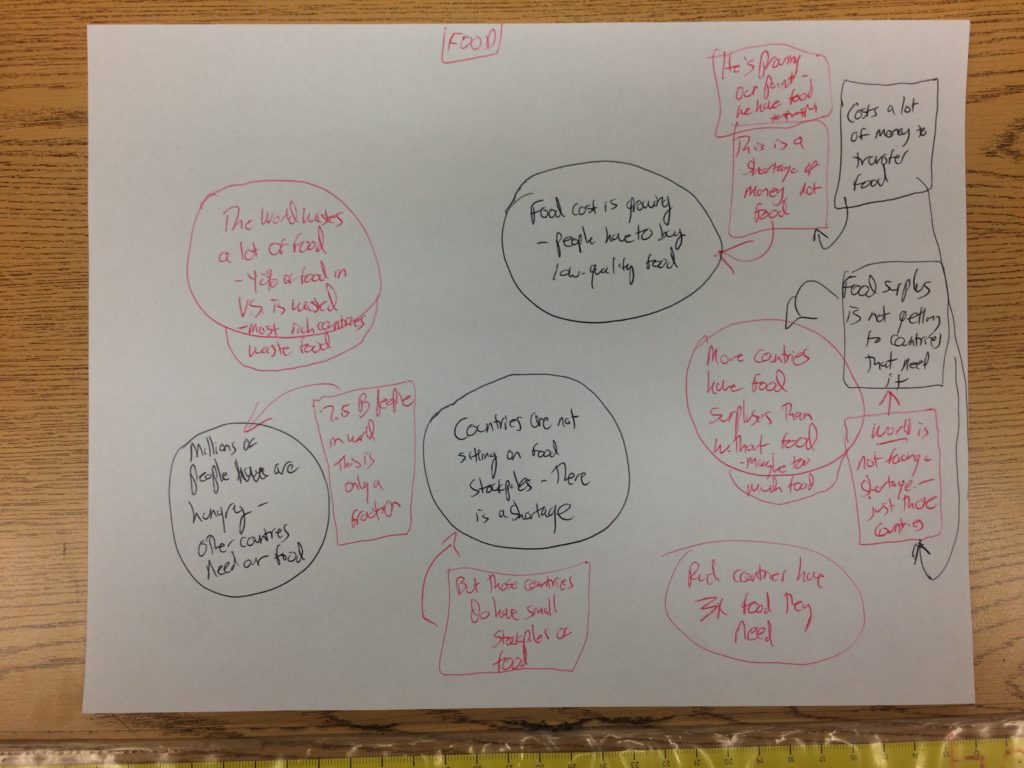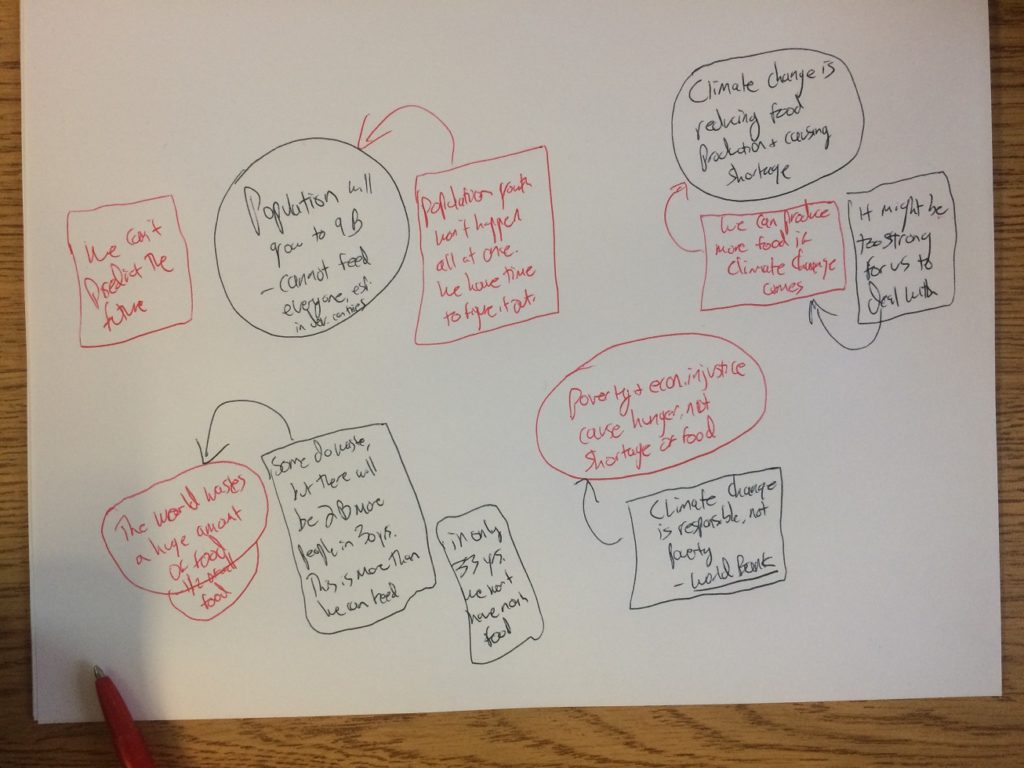
Shaping Arguments: Feedback to Particular Patterns of Student Practice
We have been working with partner middle schools on the argument-based science/social studies project, called Shaping Arguments on Natural Resources. The Debatifier posted on this project recently. We have observed certain patterns of student practice in the implementation of this project, patterns that have elicited some of our feedback “analytics,” which we think may be of interest to the broader educator community using argumentation in the classroom.
The patterns of student practice itemized really do transcend the science/social studies content in this project (on whether the world faces a severe shortage of specific natural resources), and they also transcend the grade levels in which our partner schools have so far implemented it — both because Shaping Arguments on Natural Resources can be readily adjusted for implementation in high school, and because the patterned strengths and weaknesses that students have revealed are common to students across grade levels.
First, one preliminary observation. The phrase “shaping arguments” has a double meaning: it refers both to the argument-making preparatory process (“we’re getting our arguments into shape,” “our arguments are taking shape”) and to the physical act of drawing shapes around arguments in the tracking process as the activity unfolds (circles around opening arguments, squares/rectangles around counter-arguments and rebuttal arguments).
Now, on to the feedback on patterns of student practice in Shaping Arguments on Natural Resources. To provide focus and specificity to this feedback, we tracked arguments and co-moderated the activity in a series of classrooms. The debatable issues are — to remind you — variations of the same question:
Is our world is facing a severe shortage of food?
Is our world is facing a severe shortage of fresh water?
Is our world is facing a severe shortage of energy?
Shaping Arguments Sample Round #1: Is our world facing a severe shortage of food?

- This debate gravitated toward the interesting and higher-order question over whether the current condition where some countries have more food than they need, while some countries have too little food, constitutes a global food shortage. Two refutational arguments were particularly impressive from the negative (in red).
(1) The affirmative argues that a lot of people around the world (and in the U.S.) have to buy low-quality, non-nutritious food because quality food (especially produce) has become so expensive. The negative counter-argues that if many people have to buy low-quality food because of cost that reveals that the global shortage is of money, not of food. The negative’s counter-argument is that the problem is economic, not environmental or ecological. The affirmative tries to rebut this counter-argument by saying that transferring high-quality food to poor people would cost a lot of money. The negative responds to that rebuttal by arguing that this proves the point: the issue is a lack of economic investment (or maybe economic justice), but it is not a lack of food. This is what critical thinking sounds like.
(2) The affirmative argues that the food surplus in some countries is not getting to countries that need it — and that this should be defined as a food shortage. The negative refutes the counter-argument with: that proves there are regional food shortages, not that there is a world food shortage. The affirmative is thinking analytically here when it tries to more precisely define what the debate is about. This is what evaluating competing arguments sounds like.
- The negative, though, in this same round doesn’t get full value from two arguments that it raises in the first period of the activity (the opening arguments period). The affirmative doesn’t respond with any counter-arguments to two of these negative arguments (you can see that because there are no squares with arrows drawn to connect them to these two circles): (1) Richer countries (like the U.S.) waste a substantial portion of their food (in the U.S. that wasted portion of the food supply is 40%), and (2) Richer countries have 3X as much food as they actually need. Now, these two arguments are in a way subsumed by the argumentation that I describe above (e.g., the surplus in some countries is not getting to the countries with a deficiency). Yet, these two arguments are especially well-evidenced, since the evidence has specific and credible data about the level of extra food in the better-off countries. There is such an abundance in these countries that the negative could have argued in its closing statements (the third and final period of Shaping Arguments) that it is impossible to believe that the world has a severe shortage. A substantial portion of the world’s countries have a huge excess of the food their population needs, and that condition means that we are identifying the cause of global hunger in the wrong way if we call it a food shortage. This, by the way, is precisely what a couple of the sources on the project Media List argue.
- There is a broader point here that students across grade levels can often improve upon: many students need to be thinking more about the bigger picture, the context, of the ideas and arguments they are reading, writing, listening to, and speaking about in an argument-centered classroom. How do these arguments inter-relate, and how can arguments that are being made in one portion (of a paper, or of a debate or classroom discussion, or of an article they are reading) be used in, or be relevant to, another portion. We as educators have to practice showing students how to not get so captured up in looking at (and talking or writing about) the trees, that they lose sight of the forest.
Shaping Arguments Sample Round #2: Is our world facing a severe shortage of food?

- This round of Shaping Arguments (also on the food shortage issue) highlights a common stumbling block in 6th – 12th graders’ argumentation: students will sometimes put forward claims tentatively, sometimes as questions rather than arguments. Academic argumentation calls on students to have thought through the issue further than to be in a tentative, questioning mode. This mode is interpreted as “draft work,” by academic assessors of student work (i.e. SAT essay-graders); inquiry and questioning is part of the process of thinking and writing (and thinking and speaking), but argumentation is the product of this questioning, even when argumentation retains limited residual uncertainty that the writer or speaker cannot resolve. In this Shaping Arguments round, the negative says in its closing statements that “we can’t predict the future” so we’re really not sure if there is a food shortage. And, similarly, the affirmative tries to refute the counter-argument that we can produce more food if climate change gets worse, by posing the tentative point that climate change may get too severe to allow the world to over-produce food to compensate fully. Both of these arguments are presented too tentatively; they are attenuated in their uncertainty and conditionality. We want to encourage our students to make arguments with more authority, and avoid uncertain questions in their argumentation, and to move beyond tentative, conditional claims. Truth be told, there will space for more nuanced, qualified arguments as students gain more sophistication; at the developmental level many 6th – 12th graders are at, we want to building up our their academic confidence and self-efficacy.
- We also want students to understand that the way to more emphatically make the rebuttal argument that climate change may overwhelm an effort to increase food production is to refer to evidence that supports this refutation. A hypothetical possibility is one thing (it’s a fairly clever point, so even without evidence it’s worth making), but making the rebuttal argument with reference to evidence that says that climate change is getting so bad that it will soon overwhelm our current meager efforts to address it is quite another. All arguments — initial arguments to support a position, counter-arguments, rebuttal arguments, all arguments — are much stronger when evidenced.
- Reasoning is crucial, too, in resolving clashing points and evaluating competing arguments. There’s a clear instance in this Shaping Arguments round. The negative makes an argument that it is poverty and economic injustice that are responsible for hunger, not a food shortage. The affirmative’s counter-argument (in the black box on the tracking form) is that it is climate change that is causing significantly lower food production, so therefore poverty and economic injustice are not the key factor in world hunger. The affirmative has evidence from the World Bank (we’ve underlined it on the tracking form — a technique you can use to notate when a citation is used to identify where a team’s evidence comes from). But the evidence in this case isn’t accompanies by the kind of reasoning that would make it more credible and convincing. Why is climate change a bigger cause than economic injustice for global hunger? How is the reader or listener supposed to weigh these two alternative factors? The affirmative is missing reasoning here, which weakens the persuasive force of the argument; and at the same time there is a missed opportunity for the negative to come back and supply its own reasoning that re-asserts at least a very important role for economic injustice and poverty.
These are important and complex issues for our students to research, read about, analyze, make arguments, and debate about. They can do it, though, and they can be thoroughly engaged in doing it. This feedback is offered up to help us all become more expert in teaching our students through argumentation.


Trackbacks for this post